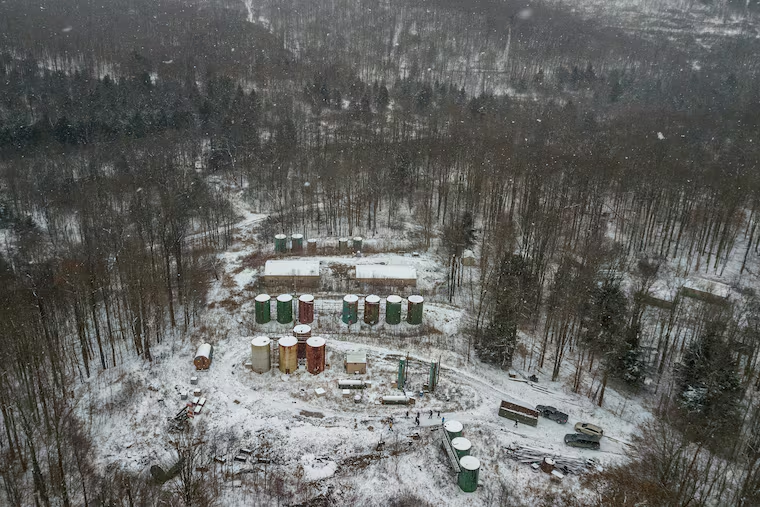Uncapped, hazardous oil and gas wells have been a norm for generations in Pa.
Pennsylvania cannot afford to kick this can down the road to the next generation.

I grew up in Oil City, Pa., in the mid-1960s, a place that was undeniably an oil town. The air constantly smelled like gas, and abandoned wells were common downtown, next to our schools, and throughout the woods where my friends and I often played. These seemingly harmless byproducts of the industry that employed most of my family and neighbors were just facts of life that we typically paid no mind.
At the time, we couldn’t have possibly known of the compounding threats stemming from the presence of those abandoned wells. After over a century of persistent drilling, numerous energy industry observers believe that there are now more than 200,000 uncapped oil and gas wells scattered across Pennsylvania, with a large percentage of these potentially hazardous sites leaking methane gas.
According to the Environmental Protection Agency, methane is more than 25 times as potent as carbon dioxide. Beyond the greenhouse gas impact of the harmful emissions produced from unplugged wells, the toxins they release have been found to damage farmland, pollute drinking water sources, and diminish air quality.
As an industry veteran who worked my first job in the fields of Seneca, Pa., with my grandfather over 50 years ago, I am acutely aware of the complex challenges presented by the expanding backlog of idled and unproductive wells. During my 15-year tenure as an oil and gas inspector for the Pennsylvania Department of Environmental Protection, I, too, often found that there was not enough public funding to cap these wells and that too many private entities did not know where to turn to remove these sites from their balance sheets.
Towns like Oil City have had to fend for themselves to address unplugged wells, or have been forced to ignore them altogether and hope for the best. It is becoming increasingly apparent that Pennsylvania communities cannot afford to kick this can down the road to the next generation.
Communities cannot afford to kick this can down the road to the next generation.
Recently, several fixes to this urgent problem have emerged and are within our reach. Thanks to creative partnerships that include the investment community, private enterprise, and public agencies, there are opportunities to deploy over $4.7 billion in federal funding from the recently enacted Infrastructure Investment and Jobs Act to plug more of these wells.
Although properly shepherding these funds will require unprecedented coordination among commercial, nonprofit, and governmental organizations, the availability of these resources presents the best opportunity in decades to expand plugging operations.
To be sure, the increased level of federal investment has already had some positive impacts. While the Department of Environmental Protection has been able to cap more wells this year than in the past six combined, the sheer amount of potentially leaking sites around the country means that commercially viable operations must also be considered essential components of the solution.
Financial heavyweights like JPMorgan Chase are already stepping up to that challenge by partnering with numerous private entities throughout North America that capitalize on the sale of carbon credits. Carbon credits are independently audited contracts that demonstrate an action taken by a commercial enterprise (such as plugging methane-leaking wells) that helped reduce a certain site’s emissions footprint. With an estimated four million uncapped wells currently scattered throughout the nation, there are more than enough sites in need of remediation to establish a vibrant, carbon-credit-centered marketplace that runs on plugging as many of these sites as possible.
For too long, sidestepping the actions needed to fully address this legacy issue has negatively impacted generations of Pennsylvanians. While a coordinated, widespread abandoned oil and gas well plugging campaign might not yet be at the forefront of our most pressing civic and commercial discussions, it is the long-awaited solution for countless at-risk communities like my hometown, Oil City.
I know there are countless crews in the commonwealth and across America that know how to find and plug these wells, and we owe it to the people who helped power this country — many of whom are from places that have always been on the front lines of this crisis — to invest in their ability to help usher in a safer, healthier future.
Scott Motter is the field operations supervisor at Zefiro Methane Corp., with offices in Bradford, Pa., which develops technologies and methodologies to plug uncapped oil and gas wells across the country. Prior to joining Zefiro, Motter served for nearly 15 years as an oil and gas inspector for the Pennsylvania Department of Environmental Protection and has worked within the oil industry for over five decades.